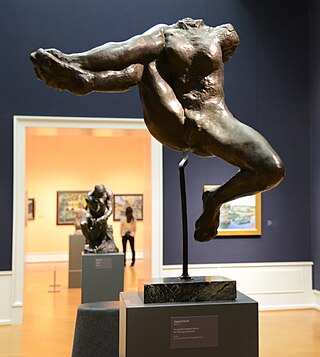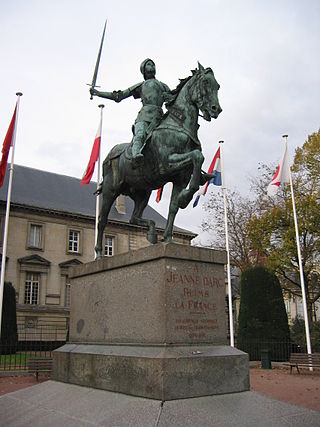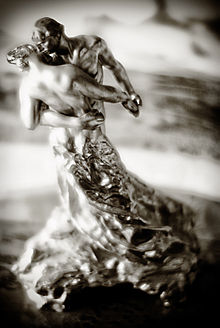
François Auguste René Rodin was a French sculptor generally considered the founder of modern sculpture. He was schooled traditionally and took a craftsman-like approach to his work. Rodin possessed a unique ability to model a complex, turbulent, and deeply pocketed surface in clay. He is known for such sculptures as The Thinker, Monument to Balzac, The Kiss, The Burghers of Calais, and The Gates of Hell.

Camille Rosalie Claudel was a French sculptor known for her figurative works in bronze and marble. She died in relative obscurity, but later gained recognition for the originality and quality of her work. The subject of several biographies and films, Claudel is well known for her sculptures including The Waltz and The Mature Age.
Guy Hain is a French art forger who produced number of fake bronze sculptures.

The Musée Rodin of Paris, France, is an art museum that was opened in 1919, primarily dedicated to the works of the French sculptor Auguste Rodin. It has two sites: the Hôtel Biron and surrounding grounds in central Paris, as well as just outside Paris at Rodin's old home, the Villa des Brillants at Meudon, Hauts-de-Seine. The collection includes 6,600 sculptures, 8,000 drawings, 8,000 old photographs and 7,000 objets d'art. The museum receives 700,000 visitors annually.

The Gates of Hell is a monumental bronze sculptural group work by French artist Auguste Rodin that depicts a scene from the Inferno, the first section of Dante Alighieri's Divine Comedy. It stands at 6 metres high, 4 metres wide and 1 metre deep (19.7×13.1×3.3 ft) and contains 180 figures.

Jessie Lipscomb, later Jessie Elborne, was an English sculptor of the human figure. She worked in Paris in a shared studio workshop in the late 1800s with French sculptor Camille Claudel and two fellow alumni from the Royal College of Art: Amy Singer and Emily Fawcett.

The Mature Age, also named Destiny, The Path of Life or Fatality (1894–1900) is a sculpture by French artist Camille Claudel. The work was commissioned by the French government in 1895, but the commission was cancelled in 1899 before a bronze was cast. A plaster version of the sculpture was exhibited in 1899, and then cast in bronze privately in 1902. A second private bronze casting was made in 1913, and it is thought that the plaster version was destroyed at that time.

Perseus and the Gorgon is a 1902 monumental sculpture by Camille Claudel that portrays a scene from Greek mythology. The artist sculpted her own likeness for Medusa's face, in anger after the break-up of her romantic partnership with sculptor Auguste Rodin. The work achieved a great notoriety throughout the years.

Tête de femme is a plaster-modelled, bronze-cast sculpture by Pablo Picasso. Dora Maar, Picasso's lover at the time, was the subject of the work which was originally conceived in 1941. Four copies of the bust were cast in the 1950s, several years after the relationship ended.

Cybele is a sculpture by French artist Auguste Rodin. It is one of the first of Rodin's partial figures known as "fragments" to be displayed as sculpture in its own right, rather than an incomplete study.

Eternal Springtime is a c. 1884 sculpture by the French artist Auguste Rodin, depicting a pair of lovers. It was created at the same time as The Gates of Hell and originally intended to be part of it. One of its rare 19th-century original casts belongs to the permanent collection of Calouste Gulbenkian Museum.

Eve is a nude sculpture by the French artist Auguste Rodin. It shows Eve despairing after the Fall.

Despair or Despair at the Gate is a sculpture by Auguste Rodin that he conceived and developed from the early 1880s to c. 1890 as part of his The Gates of Hell project. The figure belongs to a company of damned souls found in the nine circles of Hell described by Dante in The Divine Comedy. Other title variations are Shade Holding her Foot, Woman Holding Her Foot, and Desperation. There are numerous versions of this work executed as both plaster and bronze casts and carved marble and limestone.

The Musée Camille Claudel is a French national museum which honors and exhibits the art of sculptor Camille Claudel. The museum displays approximately half of Claudel's existing artwork. The Claudel museum was opened in 2017 in her teenage home town of Nogent-sur-Seine, 100 kilometers southeast of Paris.

The Bust of Auguste Rodin was sculpted by the French artist Camille Claudel in 1888-1889 as a tribute to her teacher and lover, Auguste Rodin.

Sakuntala, also known as Sakountala or Çacountala, is a sculpture by the French artist Camille Claudel, made in several versions in different media from 1886, with a marble version completed in 1905, and bronze castings made from 1905. The sculpture depicts a young couple, with a kneeling man embracing a woman leaning towards him. It was named after the play Shakuntala by the 4th-5th century Indian poet Kālidāsa, and is inspired by the moment when the title character Shakuntala is reunited with her husband Dushyanta after a long separation.

Iris, Messenger of the Gods is a bronze sculpture by Auguste Rodin. A plaster model, created between 1891 and 1894, was cast in bronze by Fonderie Rudier at various times from about 1895. Iris is depicted with her right hand clasping her right foot and her naked body posed provocatively with her legs spread wide, displaying her genitalia.

Joan of Arc is a monumental bronze sculpture by French sculptor Paul Dubois. It depicts Joan of Arc both as a warrior and as a divinely inspired visionary.



















